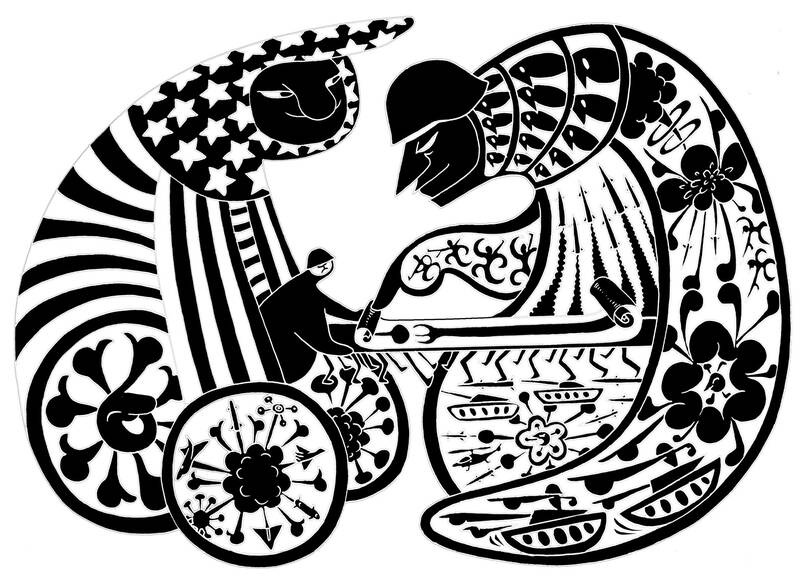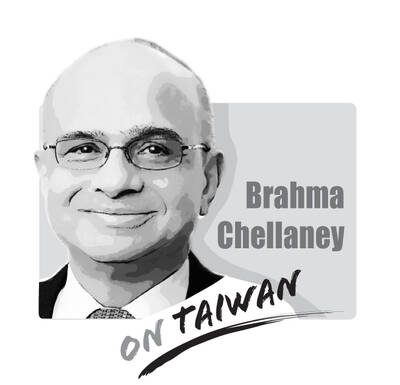Last year, some Western leaders started boasting of Russia’s “strategic defeat” in Ukraine. This was always a terrible idea and a line that Russian President Vladimir Putin never tires of citing as he pushes the false claim that he sent his armies across the border to defend Russia from Western aggression, rather than invade a former colony for gain.
Now, after more than 1,000 days of bloodshed, we are finally beginning to see the outlines of such a strategic defeat emerge, but the potential losers are Ukraine and its allies, not Putin.
I am not trying here to blame US president-elect Donald Trump in advance, should Putin succeed in crushing Ukraine and achieving his war aims in the new year. The ill-judged, leverage-destroying rhetoric from some of the US president-elect’s family and advisers does not help and needs to stop, but the primary fault lies elsewhere.

Illustration: Mountain People
Some Republicans who back Trump’s “peace now” approach say — often accurately — that they once supported a much stronger policy to back Kyiv than US President Joe Biden’s administration. They wanted the White House and US allies in Europe to give Ukraine a wider range of military aid, in bigger quantities and much faster. The war continues today, with Ukrainian forces struggling to hold the line, in large part because that did not happen in 2014 or 2022.
Less truthfully, these same Republicans now say the only way forward is to explain to Ukrainians that time is up and they must accept whatever peace deal Putin is willing to offer on a schedule of Trump’s choosing.
Ukrainian President Volodymyr Zelenskiy agrees that the war should end next year; the dispute is over how. Kyiv, like its Baltic, British, Polish and Scandinavian friends, understands that Putin has no incentive to negotiate anything and therefore would not. He has the advantage on the battlefield and sees Western resolve crumbling before his eyes.
When Putin says peace, he means Ukraine’s surrender.
There is only one answer to this conundrum that does not lead to strategic defeat for Ukraine and its NATO allies: a rapid change to align Ukrainian supplies and force regeneration with a new goal of achieving a lasting ceasefire that leaves Ukraine secure and independent.
This has to be done with deliberation and in concert.
Instead, German Chancellor Olaf Scholz on Friday last week became the first Western leader to call Putin in two years, without first making sure Kyiv and his country’s allies were on the same page and with no prospect of success.
Turkish President Recep Tayyip Erdogan soon followed by leaking ideas for a peace plan he wants to mediate.
Both men were jumping through the door Trump has opened by calling for a quick end to the war and both did so for personal political gain. Scholz is on his way out of power, having called early elections. He is desperate for a miracle to reverse his political fortunes and his uncoordinated, unplanned phone conversation with Putin was the result.
Erdogan has seen himself as a mediator between Moscow and the West since the conflict started. He had striking success in negotiating a deal to keep grain flowing from Ukraine’s blockaded ports early on, but less so when it came to the bigger picture. He has no intention of letting Trump, Scholz or anyone else steal his thunder.
As Zelenskiy said after the Scholz call, it risked opening a Pandora’s box — and he was right.
What is likely to emerge is a vanity parade of bids to “lead” on ending the war, which can benefit only Putin.
The Kremlin swiftly dismissed as “unacceptable” Erdogan’s plan to freeze the front lines, delay Ukraine’s NATO membership bid for a decade and deploy international peacekeepers to a demilitarized buffer zone.
Ukraine and its supporters need to realign strategy with resources, quickly. Kyiv’s forces are fighting as hard and with as much determination as they ever were. Their ammunition supplies and advantage in drone warfare are in better shape than for much of the past year, but not enough to compensate for Russia’s growing edge in personnel.
Attrition, a mobilization Zelenskiy unwisely delayed, and a daring, yet ultimately failed gamble to reclaim the battlefield initiative by seizing Russian territory near Kursk have all contributed. Ukrainian forces are now ceding territory at a faster rate than at any time since the spring of 2022.
None of this means Russia has overcome the manifold weaknesses that have cost it hundreds of thousands in dead and wounded, without — to date — achieving Putin’s goal of returning Ukraine to Moscow’s control. And yet Russia can sustain its losses for longer. It also now has allies willing to supply weapons and even troops to boost the war effort.
The Biden administration is right to release as much aid as it can before shuffling off the stage. Also correct, if much too late, is the reported decision to authorize Ukraine’s use of ATACMS tactical ballistic missiles against targets inside Russia.
The restrictions had been imposed for fear of Russian escalation, but Putin of course escalated regardless.
His deployments of North Korean troops and tactical ballistic missiles have already been confirmed. North Korea’s Hwasoong-11GA missiles have a maximum range of 900km and payload of 500kg, compared with 300km and about 240kg for the ATACMS. Ukraine’s allies need to coordinate their efforts in frontloading supplies to Ukraine, instead of competing to “win” the peace.
Leaders, including members of the incoming Trump administration, need to discipline their public and private messaging so Putin is left in no doubt that refusing to negotiate with Zelenskiy — as opposed to simply demanding terms of surrender — would incur costs so high they could endanger his position at home.
Taken alone, allowing Ukraine to use ATACMS inside Russia cannot do this. Nor can an extra US$5 billion or more US arms rushed to the front over the next few months. Nor the Scandinavian initiative to fund Ukraine’s expanding domestic arms production, from munitions to missiles. Nor even a timely, tactical withdrawal of troops from Kursk to the bolster the front lines within Ukraine, or the better training and more efficient deployment of newly mobilized Ukrainian forces.
However, executed together with a coherent new strategy, these moves have the potential to grind Russian territorial advances to a rapid halt and even reverse a few.
That is hardly a utopian hope; the initiative in this war has shifted multiple times since it began. Ukraine’s growing advantage in drone technologies, taken with stalemate on the ground and a growing long-range strike campaign against Russian troop concentrations, oil infrastructure and airfields behind the lines, could yet persuade the Kremlin that time is no longer on its side.
No matter how galling politically, the Biden administration and other NATO allies should be doing all they can to prepare for and, in reality, help Trump. They need to change the dynamics on the battlefield sufficiently that the next US president is dealt the hand he needs to win a genuine peace.
That would not represent the Kremlin’s strategic defeat, because it was never going to, but it could force Putin to accept a ceasefire that leaves Ukraine independent and secures against further invasion.
Marc Champion is a Bloomberg Opinion columnist covering Europe, Russia and the Middle East. He was previously Istanbul bureau chief for the Wall Street Journal. This column does not necessarily reflect the opinion of the editorial board or Bloomberg LP and its owners.

Taiwan stands at the epicenter of a seismic shift that will determine the Indo-Pacific’s future security architecture. Whether deterrence prevails or collapses will reverberate far beyond the Taiwan Strait, fundamentally reshaping global power dynamics. The stakes could not be higher. Today, Taipei confronts an unprecedented convergence of threats from an increasingly muscular China that has intensified its multidimensional pressure campaign. Beijing’s strategy is comprehensive: military intimidation, diplomatic isolation, economic coercion, and sophisticated influence operations designed to fracture Taiwan’s democratic society from within. This challenge is magnified by Taiwan’s internal political divisions, which extend to fundamental questions about the island’s identity and future
Taiwan People’s Party (TPP) Chairman Huang Kuo-chang (黃國昌) is expected to be summoned by the Taipei City Police Department after a rally in Taipei on Saturday last week resulted in injuries to eight police officers. The Ministry of the Interior on Sunday said that police had collected evidence of obstruction of public officials and coercion by an estimated 1,000 “disorderly” demonstrators. The rally — led by Huang to mark one year since a raid by Taipei prosecutors on then-TPP chairman and former Taipei mayor Ko Wen-je (柯文哲) — might have contravened the Assembly and Parade Act (集會遊行法), as the organizers had
Minister of Foreign Affairs Lin Chia-lung (林佳龍) last week made a rare visit to the Philippines, which not only deepened bilateral economic ties, but also signaled a diplomatic breakthrough in the face of growing tensions with China. Lin’s trip marks the second-known visit by a Taiwanese foreign minister since Manila and Beijing established diplomatic ties in 1975; then-minister Chang Hsiao-yen (章孝嚴) took a “vacation” in the Philippines in 1997. As Taiwan is one of the Philippines’ top 10 economic partners, Lin visited Manila and other cities to promote the Taiwan-Philippines Economic Corridor, with an eye to connecting it with the Luzon
The Chinese Nationalist Party (KMT) has postponed its chairperson candidate registration for two weeks, and so far, nine people have announced their intention to run for chairperson, the most on record, with more expected to announce their campaign in the final days. On the evening of Aug. 23, shortly after seven KMT lawmakers survived recall votes, KMT Chairman Eric Chu (朱立倫) announced he would step down and urged Taichung Mayor Lu Shiow-yen (盧秀燕) to step in and lead the party back to power. Lu immediately ruled herself out the following day, leaving the subject in question. In the days that followed, several